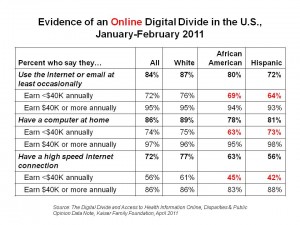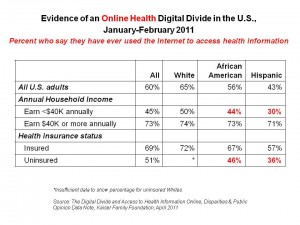 Differences in race, ethnicity and income drive online health disparities, according to a poll from The Washington Post/Kaiser Family Foundation (KFF)/Harvard University Race and Recession Survey, based on data from early 2011.
Differences in race, ethnicity and income drive online health disparities, according to a poll from The Washington Post/Kaiser Family Foundation (KFF)/Harvard University Race and Recession Survey, based on data from early 2011.
The underlying issue here is the online digital divide, which still persists for African Americans and Hispanics of lower socioeconomic status. Overall, 84% of U.S. adults use the Internet or email at least occasionally. However, only 69% of African Americans and 64% of Hispanics with less than $40,000 annual income use the Internet or email. However, income flattens Internet/email use: for people who earn over $40K a year, 95% of whites, 94% of African Americans, and 93% of Hispanics do so.
Accessing the Internet online is even more markedly different when it comes to high speed Internet connections: with 72% of U.S. adults overall accessing the Internet via broadband, only 42% of Hispanics and 45% of African Americans earning less than $40K annually have high speed connections. Again, higher incomes erase the difference in broadband use across the 3 race categories in the study. It’s a similar phenomenon regarding computer ownership at home, although a greater proportion of Hispanics with less than $40K income a year have a computer a home.
 It’s not surprising, then, that a digital divide persists when it comes to accessing health information online. The divide is worse for health citizens earning less than $40,000 a year overall — with only 45% of all U.S. adults seeking health information online, and a low 30% of Hispanics doing so in this lower income cohort. For uninsured people, there’s also a digital health divide: only 1 in 2 uninsured people access health information online, with only 36% of uninsured Hispanics and 46% of African Americans going online for health information.
It’s not surprising, then, that a digital divide persists when it comes to accessing health information online. The divide is worse for health citizens earning less than $40,000 a year overall — with only 45% of all U.S. adults seeking health information online, and a low 30% of Hispanics doing so in this lower income cohort. For uninsured people, there’s also a digital health divide: only 1 in 2 uninsured people access health information online, with only 36% of uninsured Hispanics and 46% of African Americans going online for health information.
Methodology: The Washington Post/Kaiser Family Foundation/Harvard University Survey Project polled 1,959 U.S. adults ages 18 and older in January-February 2011. The survey over-sampled African Americans and Hispanics to ensure sufficient respondents for statistical analysis.
Health Populi’s Hot Points: KFF is quick, and right, to point out that health reform in the guise of the Affordable Care Act (ACA) includes Internet-based initiatives, such as the launch of healthcare.gov, to support the implementation of the Act. In particular, the development of health insurance exchanges will require people to ‘shop’ among health insurance plans, select based on various features, and enroll in the chosen plan. The online health digital divide illustrated by this poll’s findings shows that the very people who need access to this information and enrollment facility — the uninsured, and lower-income Americans — largely don’t have the experience or access to the platform technology that underpins the ACA’s assumptions.
Perhaps it’s not as dire as all that. Perhaps. The Pew Internet & American Life’s ehealth surveys, led by Susannah Fox, have recently found that mobile web access equalizes Internet access across the races. Potentially, then, people who have the opportunity to enroll in health plans via health insurance exchanges would be able to do so via their mobile phones. But Susannah also sees the online health digital divide in the Pew’s data, which she has extensively written and spoken about.
As healthcare.gov and other web-based programs spawn out of the implementation of the ACA, program managers must recognize the reality of the divide and not assume that if they build a platform, prospective enrollees will come. The solution will be multi-pronged, and must be socialized in various ways: through community groups, senior centers, unemployment centers, churches, and other touchpoints in the uninsured health citizen’s off-line world. While some will go online, via tethered computer or via mobile, others will need a different kind of on-ramp to assess and select health plans.




 Interviewed live on BNN Bloomberg (Canada) on the market for GLP-1 drugs for weight loss and their impact on both the health care system and consumer goods and services -- notably, food, nutrition, retail health, gyms, and other sectors.
Interviewed live on BNN Bloomberg (Canada) on the market for GLP-1 drugs for weight loss and their impact on both the health care system and consumer goods and services -- notably, food, nutrition, retail health, gyms, and other sectors. Thank you, Feedspot, for
Thank you, Feedspot, for  As you may know, I have been splitting work- and living-time between the U.S. and the E.U., most recently living in and working from Brussels. In the month of September 2024, I'll be splitting time between London and other parts of the U.K., and Italy where I'll be working with clients on consumer health, self-care and home care focused on food-as-medicine, digital health, business and scenario planning for the future...
As you may know, I have been splitting work- and living-time between the U.S. and the E.U., most recently living in and working from Brussels. In the month of September 2024, I'll be splitting time between London and other parts of the U.K., and Italy where I'll be working with clients on consumer health, self-care and home care focused on food-as-medicine, digital health, business and scenario planning for the future...